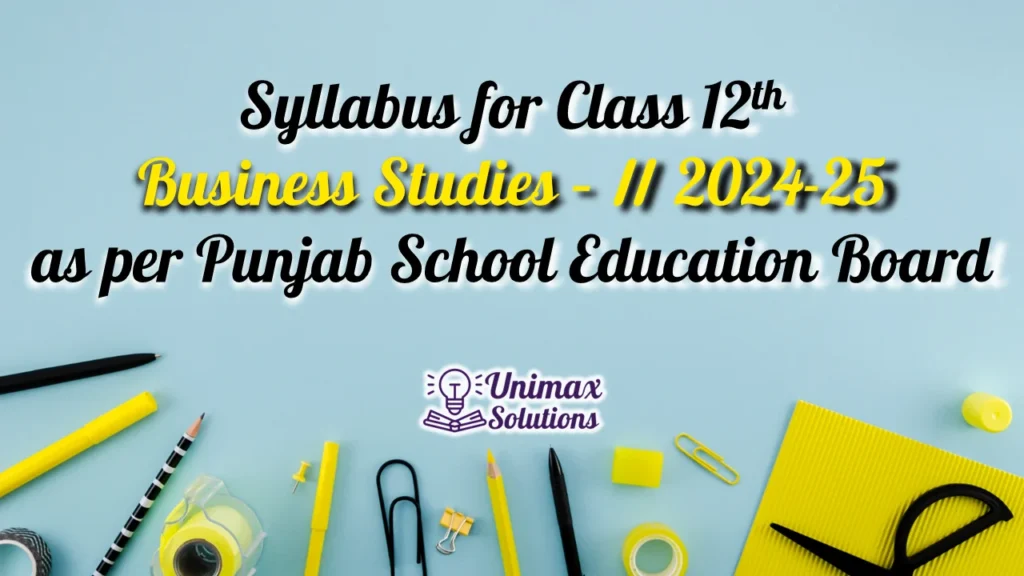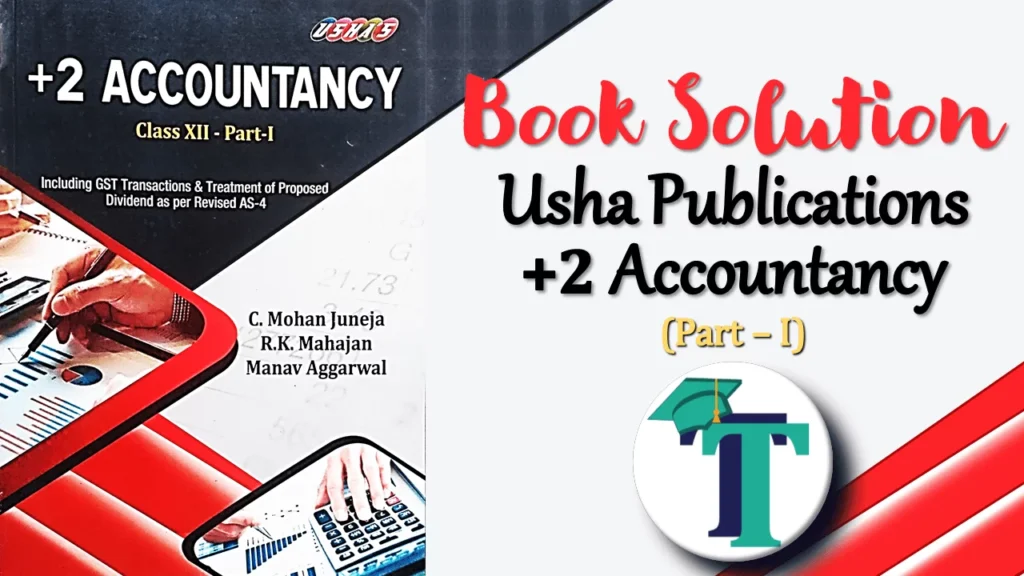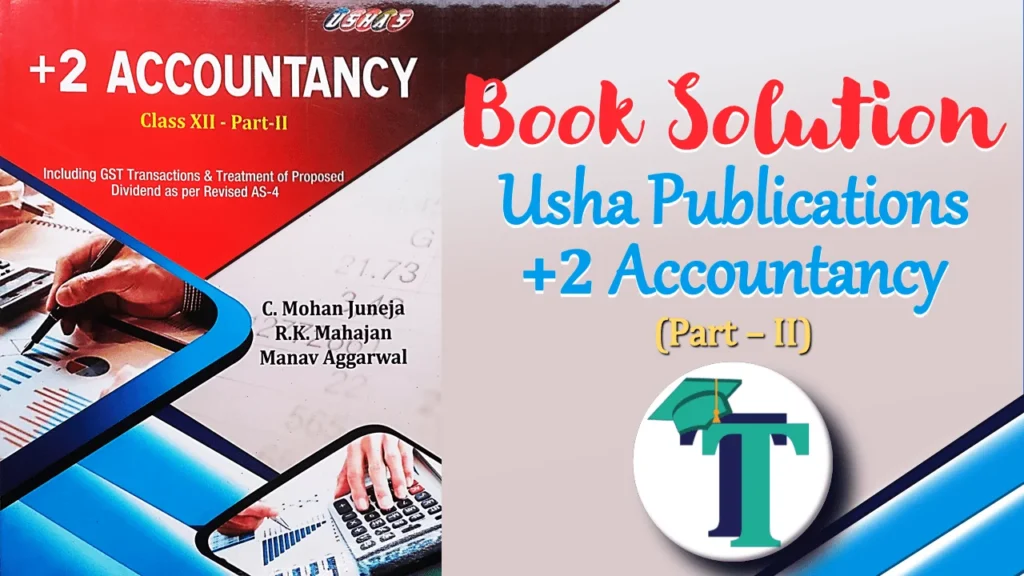
Advertisement
In this article, you can check out the Syllabus for Class 12 Business Studies – II 2024-25 – PSEB and you can also download the syllabus in the PDF Format.
CLASS-XII
BUSINESS STUDIES – II
(COMMERCE and HUMANITIES GROUP)
Time: 3 Hrs
Theory: 80 Marks
INA/Project work:20Marks
Total: 100 Marks
Complete-SYLLABUS (THEORY)
PART – A PRINCIPLES AND FUNCTIONS OF MANAGEMENT
Unit 1: Nature and Significance of Management
Management – concept, objectives, and importance
Management as Science, Art and Profession
Levels of Management
Management functions-planning, organizing, staffing, directing and controlling
Unit 2: Principles of Management
• Principles of Management- concept and significance
• Fayol’s principles of management
• Taylor’s Scientific management- principles and techniques
Unit 3: Business Environment
• Business Environment- concept and importance
• Dimensions of Business Environment- Economic, Social, Technological, Political and Legal
• Demonetization – concept and features
• Impact of Government policy changes on business with special reference to liberalization, privatization and globalization in India
Unit 4: Planning
• Concept, importance and limitation
• Planning process
• Single use and standing plans. Objectives, Strategy, Policy, Procedure, method, Rules, budget and Programme
Advertisement
Unit 5: Organising
• Concept and importance
• Organising Process
• Structure of organisation- functional and divisional concept. Formal and informal organisation- concept
• Delegation: concept, elements and importance
• Centralisation – concept and features
• Decentralization: concept, features and importance
Unit 6: Staffing
• Concept and importance of staffing
• Staffing as a part of Human Resource Management – concept
• Staffing process
• Recruitment process
• Selection – process
• Training and Development – Concept and importance, Methods of training – on the job and off the job – vestibule training, apprenticeship training and internship training
Unit 7: Directing
• Concept and importance
Elements of Directing
• Supervision- Concept and importance
• Motivation – concept, Maslow’s hierarchy of needs, Financial and non- financial incentives
• Leadership – concept, styles – authoritative, democratic and laissez faire
• Communication – concept, formal and informal communication; barriers to effective communication, how to overcome the barriers.
Unit 8: Controlling
• Controlling – Concept and importance
• Relationship between planning and controlling
• Steps in process of control
Unit 9- Coordination
Coordination: Meaning, Nature and importance.
Advertisement
PART – B BUSINESS FINANCE & MARKETING
Unit 10: Business Finance
• Financial decisions: investment, financing and dividend- Meaning and factors affecting financial decisions.
• Financial Planning – concept and importance
• Capital Structure – concept and factors affecting capital structure
• Fixed and Working Capital – Concept and factors affecting their requirements
Unit 11: Financial Markets
• Financial Markets: Concept, Functions and types
• Money market and its instruments
• Capital market and its types (primary and secondary), methods of floatation in the primary market
• Stock Exchange – Functions and trading procedure
• Securities and Exchange Board of India (SEBI) – Objectives and functions
Unit 12: Marketing
• Marketing – Concept, functions and philosophies
• Marketing Mix – Concept and elements
• Product – branding, labelling and packaging – Concept
• Price – Concept, Factors determining price
• Physical Distribution – concept, components and channels of distribution
• Promotion – Concept and elements; Advertising, Personal Selling, Sales Promotion and Public Relations
Unit 13: Consumer Protection
• Concept and importance of consumer protection
• Consumer Protection Act 2019: Meaning of consumer
• Rights and responsibilities of consumers
• Who can file a complaint?
• Redressal machinery
• Remedies available
• Consumer awareness – Role of consumer organizations and Non- Governmental Organizations (NGOs)
PROJECT WORK/INA
MARKS: 20
Advertisement
The project work marks will be allocated on the following heads.
| 1 | Initiative, cooperativeness and participation | 2 Marks |
| 2 | Creativity in presentation | 2 Mark |
| 3 | Content, observation and research work | 4 Marks |
| 4 | Analysis of situations | 4 Marks |
| 5 | Viva | 3 Marks |
| Total | 15 Marks |
Division of Marks for Internal Assesment
| 1 | Book Bank | 2 Marks |
| 2 | Average of Periodic tests | 3 Mark |
| 3 | Total | 5 Marks |
Students are supposed to select one unit out of four and are required to make only ONE project from the selected unit (consist of one project of 20 marks)
PROJECT 1: Elements of business environment (students can select any one of the topic)
(a) Changes witnessed over the last few years on mode of packaging, labelling and its impact.
(b) Changing role of women in the past 25 years.
(c) Types of packaging and its impact.
(d) Sources of business finance based on a real life company.
(e) The changes in the pattern of import and export of different products.
(f) Climate change on business environment.
PROJECT 2: Principles of Management. (Henry Fayol and Taylor)
Students are required to observe the application of the general principles of management given by Henry Fayol in a departmental store or an industrial unit, fast food outlet or any small business unit.
OR
They may observe the application of scientific management techniques by FW Taylor in a departmental store or an industrial unit, fast food outlet or any small business unit.
Project 3: Stock Exchange.
(a) Brief history of Stock Exchange in India.
(b) Listing procedure of securities in stock exchange.
(c) Dematerialisation of securities in stock exchange.
(d) Causes of fluctuations of prices in stock exchange.
Project 4: Marketing Management
Students can take the example of any consumer product like moisturizer, noodles, wipes, air conditioners, baby diapers, fruit candy, hair oil, bike, inverter, blanket, bread, ladies bag, kurti, footwear, coffee, chocolate, mobile, microwave oven, newspaper, washing powder, etc and give information about:
(a) Why they have selected this product?
(b) Name of the product.
(c) Feature of product
(d) Benefits and demerits of the product
(e) Its 5 competitive brands in the market
(f) Its unique selling proposition.
(g) The product’s brand strategy
(h) Logo and tag line of the product.
(i) Developing a promotion plan for the product.
(j) Packing of the product.
(k) Explanation of its labelling.
(l) Social message for the label.
(m) What means of transport will be used and why?
Presentation and submission of project report.
At the end of the stipulated term, each student will prepare and submit his/her project report.
Following essentials are required to be fulfilled for its preparation and submission.
- The whole project will be in a file format
- The project will be handwritten.
- The project will be presented in a neat folder.
- The students will prepare project on ruled sheets or will use an interleaf practical notebook.
- The project report will be developed in the following sequence-
• Cover page should project the title, student information, school and year.
• List of contents.
• Acknowledgements and preface (acknowledging the institution, the newspapers read, T.V. channels viewed, places visited and persons who have helped).
• Introduction.
• Topic with suitable heading.
• Planning and activities done during the project, if any.
• Observations and findings while conducting the project.
• Conclusions (summarised suggestions or findings, future scope of study).
• Appendix (if needed).
Download PDF
Download the PDF of the Syllabus for Class 12 BUSINESS STUDIES – II – PSEB For Free of cost
Check out Solutions of Various Books of Accountancy for Class 12 For PSEB
Punjab School Education Board (PSEB) Solutions of Usha Publication.
If you’re a student enrolled in the Punjab School Education Board Class 12, it’s essential to explore a wide range of books to cover the syllabus thoroughly. While the prescribed textbooks are undoubtedly valuable, supplementing your studies with additional resources can enhance your understanding and knowledge. Consider checking out other books that align with the curriculum, offering different perspectives and insights on the subjects you’re studying. These supplementary materials can provide you with alternative explanations, practice questions, and examples that may aid in clarifying complex concepts. Moreover, exploring diverse sources can expose you to a variety of writing styles and viewpoints, fostering a broader understanding of the subjects. So, seize the opportunity to expand your learning by delving into other books that can complement your studies and contribute to your academic growth.
Advertisement



